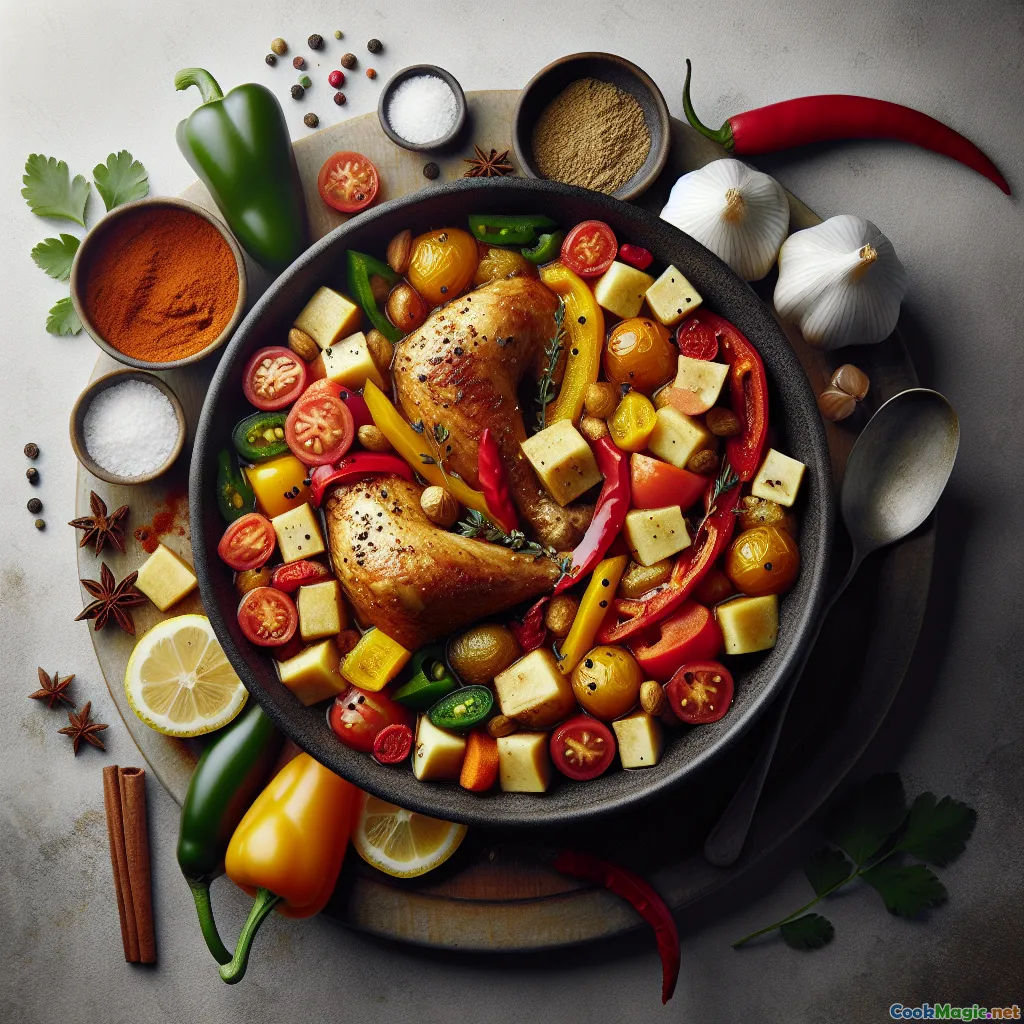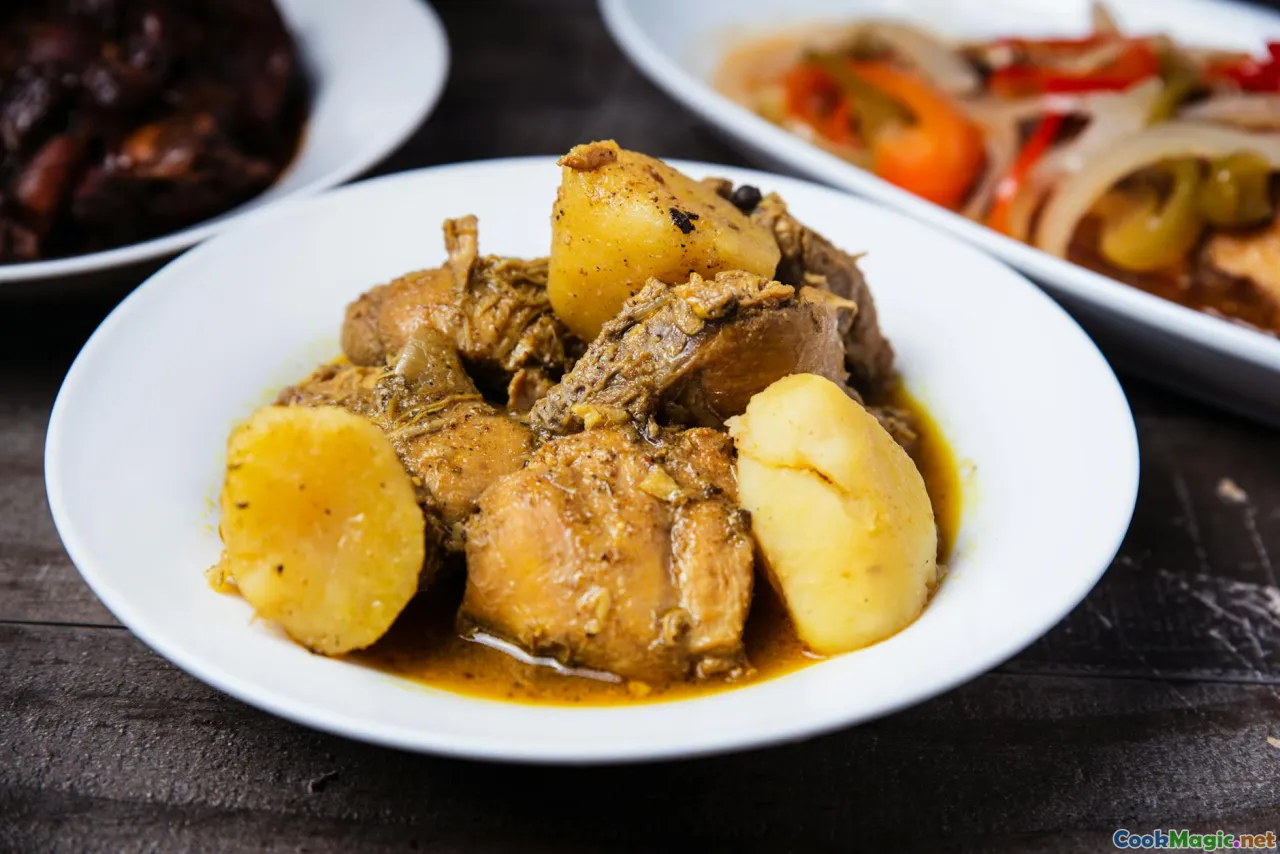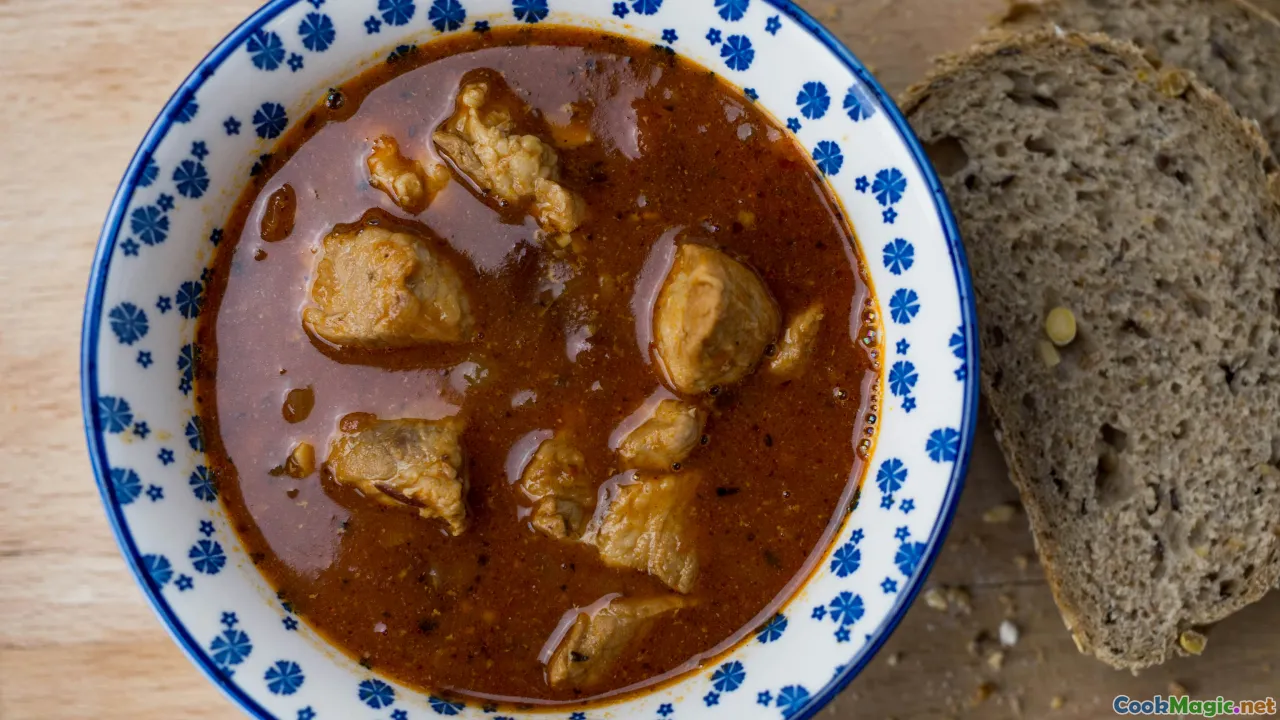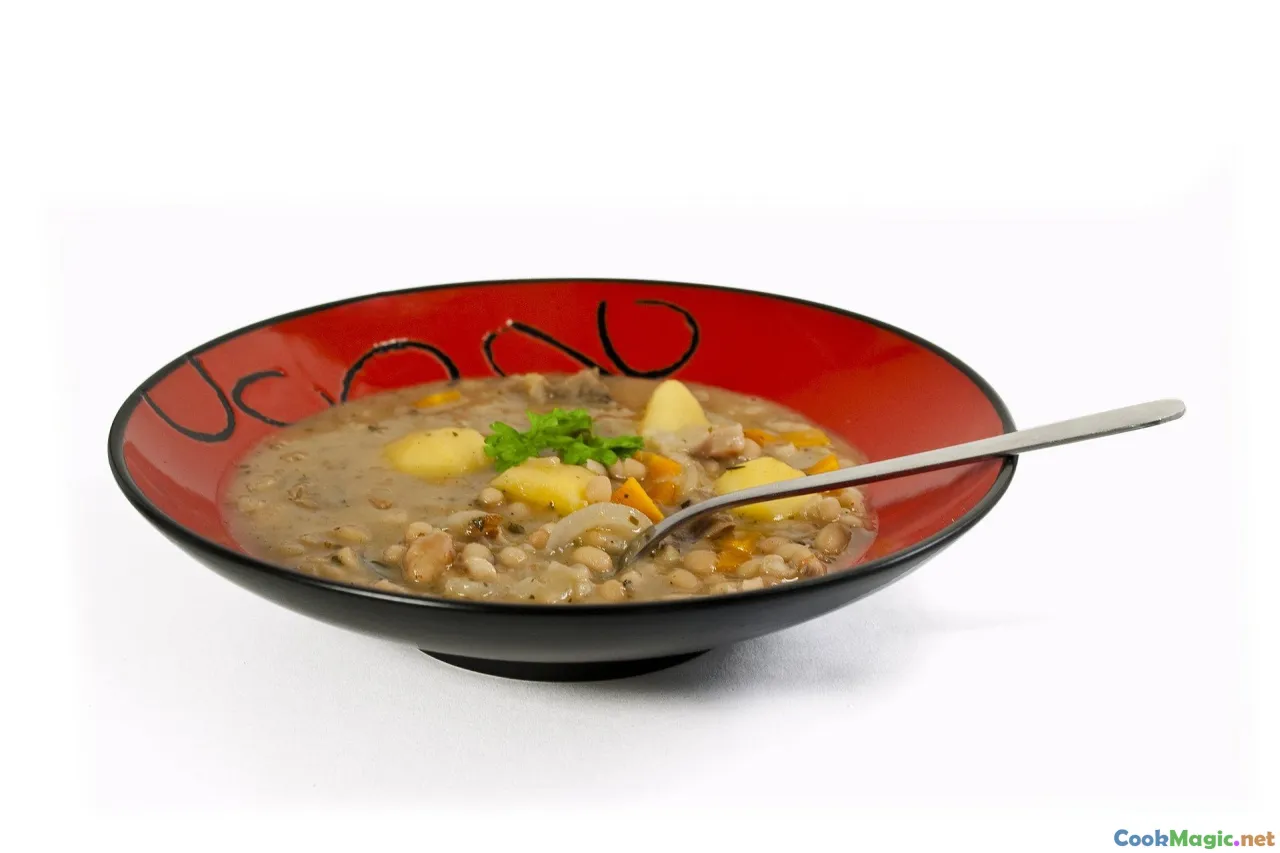
Wolno gotowany ruandyjski gulasz z kurczaka z orzeszkami ziemnymi
(Slow-Cooked Rwandan Peanut Chicken Stew)
(0 Recenzje)
Porcje
Wielkość porcji
Czas przygotowania
Czas gotowania
Całkowity czas
Kategorie
Kraj
Kuchnie
Poziom
Głosy
0
0
Wyświetlenia strony
195
195
Aktualizacja
październik 04, 2025
październik 04, 2025
Zgłoś
Zgłoś problem
Zgłoś problem
Składniki
-
1500 grams Kurczak, mieszane kawałki z kością
(Legs and thighs preferred for moistness)
-
2 tsp Sól kosher
(Divide for marinade and seasoning)
-
1 tsp Czarny pieprz
(Świeżo zmielony dla najlepszego aromatu)
-
2 tbsp Sok cytrynowy
(Adds brightness to marinade)
-
2 tbsp Olej roślinny
(For browning the chicken and aromatics)
-
2 large Cebula żółta, posiekana
(Diced small for a sweet base)
-
6 cloves Czosnek (posiekany)
(Fresh garlic enhances depth)
-
2 tbsp Świeży imbir, starty
(Signature warmth and fragrance)
-
4 medium Pomidor Roma, pokrojony w kostkę
(Ripe, juicy tomatoes preferred)
-
2 tbsp Pasta pomidorowa
(Concentrates tomato flavor and color)
-
120 grams Masło arachidowe niesłodzone
(Natural style, smooth or chunky)
-
750 ml rosół z kurczaka
(Low-sodium to control salt level)
-
2 medium Zielone plantany, obrane i pokrojone w kostkę
(Adds gentle starch and sweetness)
-
2 medium Marchewki (w plasterki)
(Rounds add color and sweetness)
-
400 grams Ziemniaki waxowe, pokrojone w kostkę
(Optional if using extra plantain)
-
1 large czerwona papryka, pokrojona w plasterki
(Added near the end for crunch and color)
-
2 leaves Liście laurowe
(Herbal backbone during simmer)
-
1 tsp Świeży tymianek
(Or 1/2 tsp dried thyme)
-
1 whole Świeża papryczka Pili-pili, przekrojona wzdłuż na pół lub na kawałki
(Dostosuj do preferencji dotyczących temperatury)
-
1 tsp Papryka wędzona
(Subtle smokiness; omit if preferred)
-
0.5 tsp Kmin mielony
(Earthy note that complements peanuts)
-
2 tbsp Liście kolendry, posiekane
(Fresh garnish at serving)
-
2 stalks Pietruszka, cienko pokrojona
(Green tops for finishing)
(Legs and thighs preferred for moistness)
(Divide for marinade and seasoning)
(Świeżo zmielony dla najlepszego aromatu)
(Adds brightness to marinade)
(For browning the chicken and aromatics)
(Diced small for a sweet base)
(Fresh garlic enhances depth)
(Signature warmth and fragrance)
(Ripe, juicy tomatoes preferred)
(Concentrates tomato flavor and color)
(Natural style, smooth or chunky)
(Low-sodium to control salt level)
(Adds gentle starch and sweetness)
(Rounds add color and sweetness)
(Optional if using extra plantain)
(Added near the end for crunch and color)
(Herbal backbone during simmer)
(Or 1/2 tsp dried thyme)
(Dostosuj do preferencji dotyczących temperatury)
(Subtle smokiness; omit if preferred)
(Earthy note that complements peanuts)
(Fresh garnish at serving)
(Green tops for finishing)
Wartości odżywcze
- Porcje: 6
- Wielkość porcji: 1 miska (300g)
- Calories: 560 kcal
- Carbohydrates: 0 g
- Protein: 38 g
- Fat: 30 g
- Fiber: 6 g
- Sugar: 8 g
- Sodium: 780 mg
- Cholesterol: 135 mg
- Calcium: 90 mg
- Iron: 3.6 mg
Instrukcje
-
1 - Marinate the Chicken:
Pat chicken dry. Toss with 1 tsp salt, black pepper, and lemon juice. Let sit while you prep aromatics.
-
2 - Brown the Chicken:
Heat oil in a heavy pot over medium-high. Brown chicken in batches, 3 to 4 minutes per side. Transfer to a plate.
-
3 - Sweat aromatics:
Lower heat to medium. Add onions with a pinch of salt; cook until translucent. Stir in garlic and ginger; cook until fragrant.
-
4 - Build tomato base:
Stir in tomatoes and tomato paste. Cook until tomatoes break down and paste darkens slightly, about 5 minutes.
-
5 - Incorporate Peanut Butter:
Whisk peanut butter into the tomato base. Gradually add warm stock, whisking to form a smooth, glossy sauce.
-
6 - Load the pot for slow cooking:
Return chicken and juices. Add plantains, carrots, bay leaves, thyme, chili, paprika, and cumin. Bring to a gentle simmer.
-
7 - Slow cook until tender:
Cover and cook on low, barely bubbling, until the chicken is very tender and sauce thickens naturally.
-
8 - Finish vegetables:
Stir in potatoes and bell pepper. Cook uncovered until potatoes are just tender and sauce is silky.
-
9 - Season and rest:
Remove bay leaves and chili. Adjust salt and lemon to taste. Let rest 5 minutes for juices to settle.
-
10 - Garnish and Serve:
Sprinkle cilantro and spring onions. Serve hot with rice, ugali, or steamed bananas.
Pat chicken dry. Toss with 1 tsp salt, black pepper, and lemon juice. Let sit while you prep aromatics.
Heat oil in a heavy pot over medium-high. Brown chicken in batches, 3 to 4 minutes per side. Transfer to a plate.
Lower heat to medium. Add onions with a pinch of salt; cook until translucent. Stir in garlic and ginger; cook until fragrant.
Stir in tomatoes and tomato paste. Cook until tomatoes break down and paste darkens slightly, about 5 minutes.
Whisk peanut butter into the tomato base. Gradually add warm stock, whisking to form a smooth, glossy sauce.
Return chicken and juices. Add plantains, carrots, bay leaves, thyme, chili, paprika, and cumin. Bring to a gentle simmer.
Cover and cook on low, barely bubbling, until the chicken is very tender and sauce thickens naturally.
Stir in potatoes and bell pepper. Cook uncovered until potatoes are just tender and sauce is silky.
Remove bay leaves and chili. Adjust salt and lemon to taste. Let rest 5 minutes for juices to settle.
Sprinkle cilantro and spring onions. Serve hot with rice, ugali, or steamed bananas.
Więcej o: Wolno gotowany ruandyjski gulasz z kurczaka z orzeszkami ziemnymi
Tender Rwandan-style chicken slow-cooked with peanuts, ginger, tomato, and plantain for a silky, comforting stew perfect for family meals.
About the dish\nSlow cooked Inyama y’Inkoko is a deeply comforting Rwandan-inspired chicken stew that leans into East Africa’s love for groundnuts, gentle spice, and slow, patient cooking. The name itself signals its heart: inyama y’inkoko means chicken meat in Kinyarwanda, and this rendition layers tomatoes, ginger, and natural peanut butter into a velvety sauce that tenderizes bone-in chicken over low heat. Plantain and carrots add sweetness and body, while herbs and a whisper of chili keep the flavors bright.\n\nUnlike quick pan sauces, this stew is built to evolve as it cooks. Browning the chicken gives the pot a savory foundation; sweating onions, garlic, and ginger unlocks sweetness and warmth; and whisking peanut butter with stock creates an emulsion that thickens gently as collagen renders from the bones. The result is a glossy, nutty gravy that hugs every bite.\n\n## Flavor profile and texture\nExpect a balanced, savory profile: ginger’s lift, tomato’s brightness, peanut’s nutty richness, and the delicate sweetness of plantain. The sauce finishes silky and spoon-coating without feeling heavy. Bone-in chicken—especially thighs and drumsticks—stays succulent, with meat that slides off the bone.\n\n## Tips and notes\n- Choose the right peanut butter: Natural, unsweetened peanut butter is essential. Added sugars can tip the stew too sweet. If yours is thick, warm it slightly to whisk in smoothly.\n- Control the simmer: The key to silkiness is a low, steady bubble. Too vigorous, and the sauce may split; too low, and flavors underdevelop. Aim for a gentle blip.\n- Plantain timing: Green plantains hold up beautifully. If using riper yellow plantains, add them later to keep shape.\n- Browning matters: Do not rush the sear. Deeply browned chicken and a lightly caramelized onion base create complexity without extra spices.\n- Adjust heat: Pili-pili can be assertive; slit it and simmer whole for fragrance, or chop for more heat.\n- Finishing acidity: A squeeze of lemon at the end brightens the nutty sauce and balances richness.\n\n## Serving suggestions\nThis stew is wonderful with steamed rice, ugali, or boiled green bananas. For an elegant table, serve with lightly charred greens like sukuma wiki or blanched spinach dressed in lime. A side of simple cucumber and tomato salad adds crunch and freshness.\n\n## Make it yours\n- Leafy greens: Stir in chopped spinach or amaranth leaves for the final 5 minutes.\n- No plantain? Substitute firm sweet potato or add more carrots and potatoes.\n- Vegetarian variation: Swap chicken for hearty mushrooms and chickpeas, and use vegetable stock. The peanut-tomato base is versatile.\n- Spice palette: Keep it minimal and let ginger and peanuts lead, or introduce warm notes like coriander seed or grains of paradise for a subtle twist.\n\n## Cultural notes and significance\nPeanuts feature widely across East and Central African cuisines, enriching sauces and stews from Rwanda to Uganda and the Democratic Republic of the Congo. While every family and region has its own approach, the marriage of poultry with groundnuts and tomato is time-honored, prized for its balance of comfort and sustenance. Slow cooking in a communal pot is as much about flavor as it is about rhythm—meals that simmer while stories are shared and the day unwinds. In Rwanda, where staple accompaniments like rice, isombe, and bananas are common, a chicken stew like this can anchor celebratory or family meals.\n\n## Technique deep dive\n- Emulsification: Whisking peanut butter into hot tomato base, then slowly streaming in stock, creates a stable emulsion. If the sauce looks oily, lower the heat and whisk in a splash more stock.\n- Bone-in advantage: Bones contribute gelatin, body, and a round mouthfeel. They also protect the meat from drying out during long cooking.\n- Layered salting: Season the chicken, season the onions, and taste again at the end. Small, layered amounts of salt yield a more integrated flavor.\n\n## Storage and make-ahead\nThis stew is even better the next day. Chill promptly; it will keep 4 days refrigerated, or up to 3 months frozen. Reheat gently, adding a splash of stock or water to loosen the sauce.\n\n## Troubleshooting\n- Sauce too thick: Whisk in warm stock or water, a little at a time.\n- Sauce too thin: Simmer uncovered to reduce, stirring to prevent sticking.\n- Split sauce: Take off heat and whisk in a tablespoon of cool stock. Return to low heat and stir gently.\n\n## Final thoughts\nSlow cooked Inyama y’Inkoko rewards patience. With simple ingredients treated carefully—golden chicken, fragrant aromatics, and the humble peanut—it transforms into a celebratory stew that feels both familiar and new. Whether it is your first time cooking a Rwandan-inspired dish or a return to beloved flavors, this bowl promises comfort, generosity, and the quiet pleasure of slow food.
Oceń przepis
Dodaj komentarz i recenzję
Opinie użytkowników
Na podstawie 0 recenzji
Nie dodano jeszcze żadnych recenzji.
Komentarze nie zostaną zatwierdzone do publikacji, jeśli będą SPAM-em, będą obraźliwe, niezwiązane z tematem, będą zawierały wulgaryzmy, będą zawierały atak personalny lub będą promowały jakąkolwiek formę nienawiści.


















